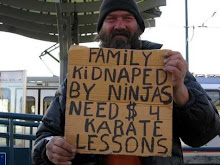I have to admit this with no small amount of guilt: I like pro wrestling. That's not to say I watch it, mind you. I rarely do, because I don't like the modern product. What I like, though, is the business itself; the combination of athleticism and stunt work with the characters and storylines of a comic book is fascinating to me.
I grew up during the era of wrestling where the regional territories were fading in favor of a national, big-name product. Rather than being based around, say, Memphis or the Tri-State, many wrestling leaders were looking to land national TV deals and centralize promotion control. However, there were still several big confederations when I was growing up, particularly the NWA and AWA. Every Saturday morning, I watched for the Rock & Roll Express to pull out a victory over the Midnight Express, barring interference from the tennis racket-wielding Jim Cornette. I didn't know what a "face" (good guy) or a "heel" (bad guy) was, but I could pick them out. Back then, of course, I thought it was real. Most little kids do. I think I was probably younger than ten when I realized that at least some of the moves were faked (basically, I looked at someone taking a flurry of punches without bruising or blood, and said, "Bullshit"). I no longer bought the "kayfabe".
That, however didn't deter me from becoming excited about the rivalries and action, much in the same way you'd root for someone in a movie or TV show. What I discovered was that, while some of the stuff was clearly faked (I remember watching a Wrestlemania video where Andre the Giant "sold" a ring post ram where his head didn't come within a foot of the thing), a man being thrown from the top rope is a little hard to completely stage. I started to examine the matches as stunt arrangements, and I rapidly discovered that I was actually more impressed with the wrestlers in this case.
Wrestling, while often choreographed to a greater or lesser extent, relies heavily on the ability to absorb punishment. Sure, the punishment can be mitigated, but many of the things that occur in and around the ring just aren't supposed to happen to a human body. Take, for example, a vertical suplex. A wrestler lifts an opponent over their head and then down into a flat-on-the-back position. It's a move that looks good, and, with proper positioning, much of the impact can be distributed in a fairly harmless manner. Take that same move six or eight feet in the air, off of a turnbuckle, and you have a different animal. The principle is the same, but the force is greatly increased, and there is much more opportunity for injury. The vertical suplex is a very mild example. Many, if not most of the more high-flying moves entail far greater risk of injury than even the most vicious-appearing mat wrestling moves.
That is not to say that technical moves cannot cause injury. Rather, modern wrestling's shootfighting roots are very real. The difference is primarily found in that a hold can often be made to look painful without actually being so, and many joint and pressure locks can easily cause lasting damage while appearing no different than a similar move being "sold" as painful. I, myself, have been on the receiving end of a few demonstrations, and can attest that, if someone wanted to hurt you with a "fake" wrestling hold, they likely could.
Add to this the storylines of the wrestling world, the "kayfabe" of evildoers and freaks versus heroes and patriots, and you had something of what drew me in long ago. "Kayfabe" actually does not refer to these stories, as such, but rather the idea that they were real, and that these guys didn't go out for a beer after the show. Few companies enforce kayfabe anymore, as the cat has long since been out of the bag. Back when I was a kid, it was simple. Sure, there were quite a few bizarre plot lines and characters (Kevin Sullivan's weird devilish characters come to mind), but there were plenty of basic heroes and villains. A rivalry like that of Ricky Steamboat and Ric Flair was easy to understand, and was that much more exciting because it involved two of the most talented and technically skilled wrestlers in history. I don't care for much of the modern plotting, which is much of the reason I don't watch anymore. I don't tune in for the acting and story, which is what much of the modern "sports entertainment" model is based on. I like the stunt work.
There are some people who give their all for the business, sacrificing themselves to entertain the fans. I admire Mick Foley, in particular. Wrestling was his dream, and he followed it, destroying his body (and some of his mind) in the process. He took abuse that I didn't think a human body could possibly endure, and came back for more. He followed that with several bestselling books, and expanded himself into other realms, all while embracing the business that he loved, even just as a personality when he could no longer wrestle.
I've recently been playing some wrestling sim games by programmer Adam Ryland. One takes place in a world where the competition is "real", and is treated as a strategy/roleplaying game where you develop a wrestler and try to win matches and build a career. The other is a "booking" sim, which is more like real life. You run a wrestling company, and must book shows, gain sponsors, manage personalities, write storylines, hire and fire; in short, it's a very deep simulation that encompasses multiple continents, companies, and a massive amount of interrelated data. It is a smorgasbord of goodness for someone familiar with wrestling's background, and an introduction into its complexities for someone who isn't.
I've noticed that ESPN Classic is airing old AWA shows late at night. I've got one recorded to the DVR now. I'll watch it later and spend some time remembering Saturday mornings.
Subscribe to:
Post Comments (Atom)






No comments:
Post a Comment